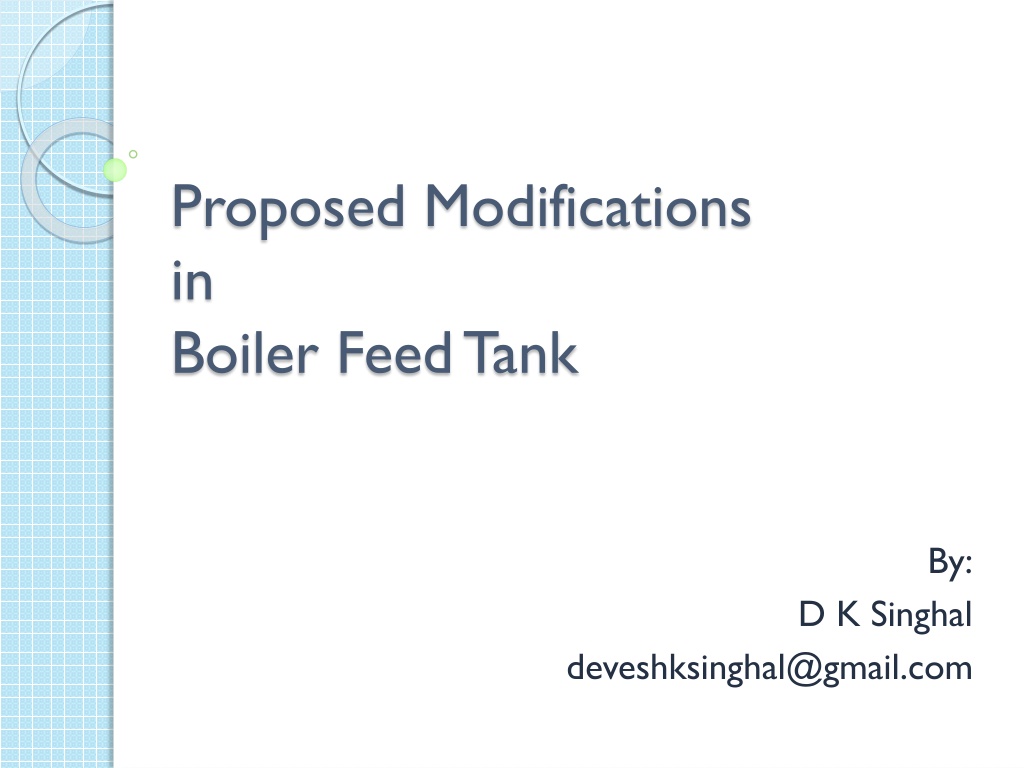Proposed Modifications in Boiler Feed Tank for Improved Efficiency
The proposed modifications in the boiler feed tank aim to enhance efficiency by utilizing two separate tanks for cold makeup water and hot condensate. This innovative approach addresses the limitations of existing large tanks, reducing energy losses and insulation costs. By incorporating a small hot condensate tank and a cold makeup water tank, the system can provide uninterrupted feed water supply to the boiler with optimized insulation and energy usage.
Download Presentation

Please find below an Image/Link to download the presentation.
The content on the website is provided AS IS for your information and personal use only. It may not be sold, licensed, or shared on other websites without obtaining consent from the author. Download presentation by click this link. If you encounter any issues during the download, it is possible that the publisher has removed the file from their server.
E N D
Presentation Transcript
Proposed Modifications in Boiler Feed Tank By: D K Singhal deveshksinghal@gmail.com
Conventional Boiler Feed Tank The fundamental object of having a boiler feed tank is to ensure uninterrupted supply of boiler feed water to the boiler. deveshksinghal@gmail.com 2
Problems with Existing Tank A boiler feed water tank is generally a huge tank suitable of storing sufficient feed water for 3-4 hours of operation. That is why, it cannot be kept pressurized (or fully closed) easily and economically. With open tank, flash vapors coming out result in significant energy losses. deveshksinghal@gmail.com 3
Problems with Existing Tank Big size results in increased insulation costs. Furthermore, as the surface area is high, heat losses are significant even after good insulation. deveshksinghal@gmail.com 4
Proposed Approach Proposed approach uses two separate tanks connected to each other. One tank contains cold makeup water, and needs no insulation. The second tank is relatively small, which can be insulated easily and efficiently. deveshksinghal@gmail.com 5
Cold Make Up Water Tank This tank can be made suitable sized to hold adequate make up water in case there is inadequate condensate supply. The elevation of this tank is as per the boiler designer recommendations, as its head will give sufficient NPSH to feed pump. deveshksinghal@gmail.com 6
New Small Hot Condensate Tank The proposed small hot condensate tank is a small tank strategically placed in the circuit. Its capacity should be adequate for typically 15-20 minutes of operation. As the size is substantially small, it can be properly insulated. deveshksinghal@gmail.com 7
New Small Hot Condensate Tank This tank has an outlet to boiler feed pump near the top. The make up water enters the tank at the bottom. At extreme top, there is a small venting line that vents flash vapors generated by condensate to the top of cold make up water tank. deveshksinghal@gmail.com 8
The Scheme deveshksinghal@gmail.com 9
Small Tank The small tank is a closed vessel in which hot condensate enters from the top. The condensate is removed from top, thus, hotter condensate goes to boiler feed pump. In case condensate supply is lesser than that required by boiler feed pump, cold makeup water enters from the bottom. deveshksinghal@gmail.com 10
Small Tank Thus, the cold water enters the boiler if and only if all hot condensate has been consumed. As the make up supply is without a valve, there is no risk of tank becoming empty and dry run of boiler feed pump. deveshksinghal@gmail.com 11
Small Tank In case the boiler feed pump is off, and condensate is coming from process, the same pushes the colder water at the bottom of small tank back to the main feed water tank through make up line. Even if some hot condensate is pushed back through this line, this returns back when the pump is restarted. deveshksinghal@gmail.com 12
Insulation The small tank and the make up water line (as it may get flooded with hot condensate occasionally) needs insulation. Being this tank much smaller, you can insulate it well. Typically, the insulation costs are reduced to just 15-20% only. deveshksinghal@gmail.com 13
Main Feed Water Tank This way, the main feed water tank remains at lower temperature, and hence no insulation is required. deveshksinghal@gmail.com 14
Thank You. D K Singhal +91-9412713426 deveshksinghal@gmail.com deveshksinghal@gmail.com 15























